
Tequila is a distilled beverage made from the blue agave plant, primarily in the area surrounding the city of Tequila 65 km (40 mi) northwest of Guadalajara, and in the Jaliscan Highlands of the central western Mexican state of Jalisco.

The evergreen bagworm, commonly known as bagworm, eastern bagworm, common bagworm, common basket worm, or North American bagworm, is a moth that spins its cocoon in its larval life, decorating it with bits of plant material from the trees on which it feeds.

Mezcal, sometimes spelled mescal, is a distilled alcoholic beverage made from any type of agave. The word mezcal comes from Nahuatl mexcalli, which means "oven-cooked agave", from metl and ixcalli. Traditionally the word "mezcal" has been used generally in Mexico for all agave spirits and it continues to be used for many agave spirits whether these spirits have been legally certified as "mezcal" or not.

Agave americana, commonly known as the century plant, maguey, or American aloe, is a flowering plant species belonging to the family Asparagaceae. It is native to Mexico and the United States, specifically Texas. This plant is widely cultivated worldwide for its ornamental value and has become naturalized in various regions, including Southern California, the West Indies, South America, the Mediterranean Basin, Africa, the Canary Islands, India, China, Thailand, and Australia.

Baylisascaris is a genus of roundworms that infect more than fifty animal species.
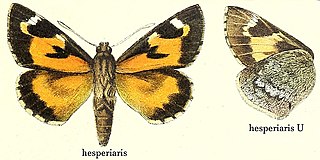
Aegiale hesperiaris, commonly known as the tequila giant skipper, is a species of butterfly in the family Hesperiinae. It is the only species in the monotypic genus Aegiale. Its caterpillar is one of two varieties of edible "maguey worms" that infest maguey and Agave tequilana plants.

Agave syrup, also known as maguey syrup or agave nectar, is a sweetener commercially produced from several species of agave, including Agave tequilana and Agave salmiana. Blue-agave syrup contains 56% fructose as a sugar providing sweetening properties.

Diaprepes abbreviatus, also known as the diaprepes root weevil, citrus root weevil and sugarcane rootstock borer weevil, is a species of weevil that is native to the Caribbean, where in Spanish it is colloquially called chichí. It has become an invasive pest in several locations in the United States.

Agave angustifolia is a species of agave plant which is native to Mexico and Central America. It is used to make mezcal and also as an ornamental plant. The cultivar 'Marginata' that white margins on the leaves is a popular variety cultivated in botanical gardens and backyards. It is very closely related to blue agave Agave tequilana, but is used to make the distilled alcoholic beverage mezcal instead of tequila, and is the predominant agave species grown in the Mexican state of Oaxaca.

The palm weevil Rhynchophorus ferrugineus is one of two species of snout beetle known as the red palm weevil, Asian palm weevil or sago palm weevil. The adult beetles are relatively large, ranging between 2 and 4 centimetres long, and are usually a rusty red colour—but many colour variants exist and have often been classified as different species. Weevil larvae can excavate holes in the trunks of palm trees up to 1 metre (3.3 ft) long, thereby weakening and eventually killing the host plant. As a result, the weevil is considered a major pest in palm plantations, including the coconut palm, date palm and oil palm.
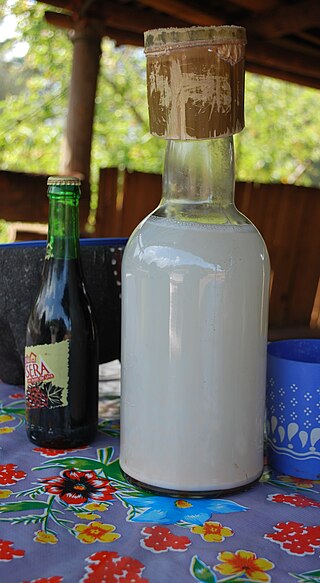
Pulque, occasionally known as octli or agave wine, is an alcoholic beverage made from the fermented sap of the maguey (agave) plant. It is traditional in central Mexico, where it has been produced for millennia. It has the color of milk, a rather viscous consistency and a sour yeast-like taste.

Agave is a genus of monocots native to the arid regions of the Americas. The genus is primarily known for its succulent and xerophytic species that typically form large rosettes of strong, fleshy leaves. Agave now includes species formerly placed in a number of other genera, such as Manfreda, ×Mangave, Polianthes and Prochnyanthes.

The South American palm weevil, Rhynchophorus palmarum, is a species of snout beetle. The adults are relatively large black beetles of approximately one and a half inch in length, and the larvae may grow to two inches in length.

Oaxacan cuisine is a regional cuisine of Mexico, centered on the city of Oaxaca, the capital of the eponymous state located in southern Mexico. Oaxaca is one of Mexico's major gastronomic, historical, and gastro-historical centers whose cuisine is known internationally. Like the rest of Mexican cuisine, Oaxacan food is based on staples such as corn, beans and chile peppers, but there is a great variety of other ingredients and food preparations due to the influence of the state's varied geography and indigenous cultures. Corn and many beans were first cultivated in Oaxaca. Well known features of the cuisine include ingredients such as chocolate, Oaxaca cheese, mezcal and grasshoppers (chapulines) with dishes such as tlayudas, Oaxacan style tamales and seven notable varieties of mole sauce. The cuisine has been praised and promoted by food experts such as Diana Kennedy and Rick Bayless and is part of the state's appeal for tourists.
An Oaxacan wedding is a traditional ritual that involves the participation of both the bride's and groom's family along with the community. The main decision makers of the wedding are the fathers of the groom and bride. The father of the groom must first ask for the bride's hand and if the bride's father accepts two weeks later they begin to arrange the wedding. If the case is that the groom does not have a father he can have an elder represent him. At this gathering the groom's side of the family brings with them fruits, bread, and alcoholic beverages. The godparents of both the bride and groom attend this gathering, who are the godparents of baptism, first communion, confirmation, as well as the new wedding godparents of the couple. The godparents are chosen by the couple usually because of a blood tie or a friendship. After this the groom must show his commitment to his bride's family by doing any chores the bride's family needs until the wedding date. The chores can vary from sweeping to helping the father in law with work in the ranch.
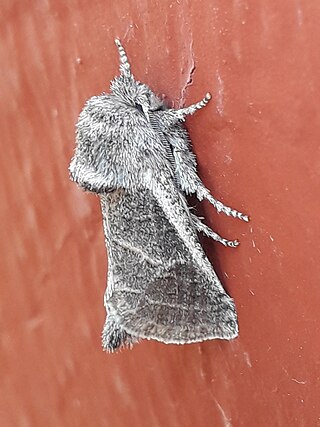
Comadia redtenbacheri is a moth in the family Cossidae. It is found in North America, where it has been recorded from Mexico and southern Texas.

Agave atrovirens, called maguey verde grande is a type of century plant native to Oaxaca, Puebla and Veracruz states in Mexico. It is the largest of all the Agaves, occasionally reaching a weight of two long tons. Each succulent leaf can be up to 14 feet 9 inches in length and weigh one hundred pounds (45 kg) apiece. In the variety A. a. cochlearis these leaves can also be up to 16 inches (41 cm) wide. As in other Agaves the leaves form a rosette, from the center of which, after many years, a panicle of flowers emerges on a long scape or peduncle which at first looks like a vast stalk of asparagus, but later grows to more than forty feet in height, develops side branches near the top and numerous flowers which open red and gradually turn yellow. Agave salmiana, the species with the tallest inflorescences, is frequently lumped with A. atrovirens as the varieties A. a. salmiana or A. a. sigmatophylla. If this is valid, then A. atrovirens also has the tallest inflorescences of any Agave, and of any known plant. Each rosette flowers and fruits once, then dies. According to Fayaz this is one of the species which makes offsets or "pups". A. atrovirens is one of the pulque agaves used in the production of mezcal.
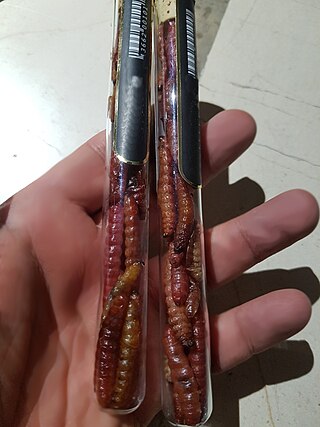
Maguey worms are either of two species of edible caterpillars that infest maguey plants.
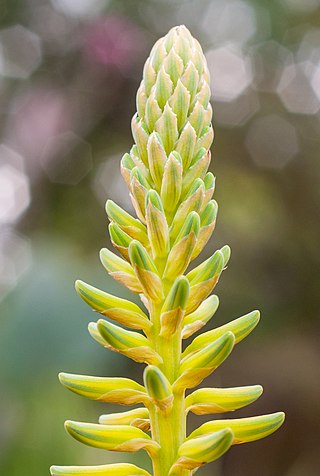
The maguey flower, in Spanish, flor de maguey, also known locally as gualumbo, hualumbo, quiote or jiote is a typical product of Mexican cuisine, cultivated mainly in the rural areas of the center of the country. Due to its difficult availability, it is considered a delicacy. Maguey flowers are harvested and consumed closed, since once opened (ripened), they have a bitter taste.
Miske is an Ecuadorean distilled alcoholic beverage made from the sap of agave plants.


















